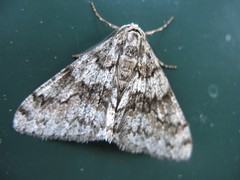Ada Lovelace Day is a day for bloggers to celebrate women in science and technology. I'm not sure if this post will fall exactly within the parameters of what was intended for this day, but I would like to take the opportunity to honor the memory of one of my birding role models, the late Claudia Wilds.
I first ran across Wilds' name while reading Jack Connor's guide for would-be intermediate birders, The Complete Birder. This book delved deeper into the identification of complicated groups such as warblers, shorebirds, terns and gulls than many field guides of the time went (The Complete Birder was originally published in 1988). Connor quoted identification criteria in a conversational style; I subsequently found out that he was citing articles in the American Birding Association's journal Birding, but at the time I first read (and reread and reread) his book, I had no idea that the ABA even existed. I just thought Connor knew some birders, and that Claudia Wilds sure knew a lot about shorebirds.
I had already caught the shorebird bug by the time I first read The Complete Birder. The identification of birds (and especially difficult groups such as shorebirds or gulls) was an irresistible intellectual challenge. Wilds' work offered the tools to get to grips with these challenges. Once I found ABA and became a member, and then bought up all the back issues of Birding I could get, I discovered Wilds' own articles, and her critiques of other shorebird references.
In the meantime, as a birder in the mid-Atlantic, I had also found my way to Bombay Hook NWR and other Delaware sites. Lo and behold, Wilds had also written a bird-finding guide to the DC area (which included Delaware). Not only did it cover birds, it also dealt with practical matters such as Delaware speed traps.
Eventually, I wrote a few articles for Birding myself, on old bird books. At that point, Wilds was Associate Editor of Birding, and I have at least one manuscript marked up by her (as well as Paul Lehman, Birding's editor at the time).
It wasn't until Wilds' untimely death from cancer in 1997 that I found out that she had had an illustrious career as a linguist with the U. S. State Department before she came to birding (if you Google her name, you will find references from both chapters of her life). I never met her in person, but she was and continues to be an inspiration to me.
Oh, and the image for this post? A run of Western Birds (originally California Birds) showed up in the Buteo Books catalog in the late 90s, so I snapped it up (those being the days when money was no object when it came to building my birding reference library). Look closely at the upper right-hand corner of that cover. It says "Wilds."
An incomplete list of further reading:
Claudia Wilds: Finding Birds in the National Capital Area. Smithsonian Institution Press.
Claudia Wilds: Separating the Yellowlegs. Birding 14:172-178
Claudia Wilds: On Taking a Notebook Afield
Claudia Wilds and David Czaplak: Yellow-legged Gulls in North America. Wilson Bulletin 106:344-356 (PDF)
Claudia Wilds and Robert Hilton: Emerging from the Silent Majority: Documenting Rarities
Paul Lehman: A Tribute to Claudia Wilds (1931-1997) Birding 29:358-360
Claudia Wilds Fund of the Montgomery (MD) Bird Club (scroll to page 8 of the PDF)

